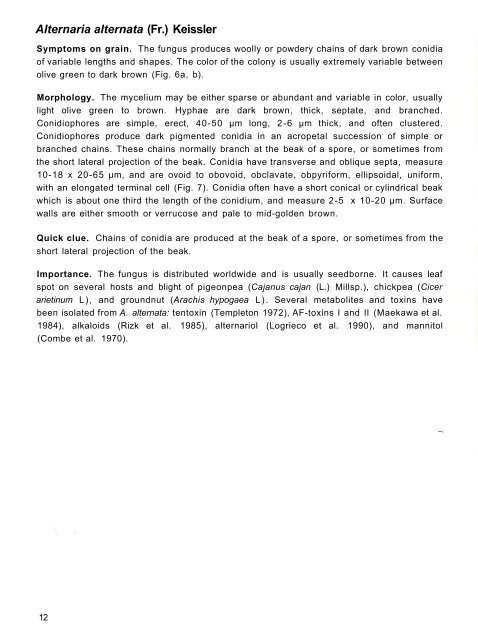A Pictorial Guide for the Identification of Mold ... - OAR@ICRISAT
A Pictorial Guide for the Identification of Mold ... - OAR@ICRISAT
A Pictorial Guide for the Identification of Mold ... - OAR@ICRISAT
You also want an ePaper? Increase the reach of your titles
YUMPU automatically turns print PDFs into web optimized ePapers that Google loves.
Alternaria alternata (Fr.) Keissler<br />
Symptoms on grain. The fungus produces woolly or powdery chains <strong>of</strong> dark brown conidia<br />
<strong>of</strong> variable lengths and shapes. The color <strong>of</strong> <strong>the</strong> colony is usually extremely variable between<br />
olive green to dark brown (Fig. 6a, b).<br />
Morphology. The mycelium may be ei<strong>the</strong>r sparse or abundant and variable in color, usually<br />
light olive green to brown. Hyphae are dark brown, thick, septate, and branched.<br />
Conidiophores are simple, erect, 40-50 μm long, 2-6 μm thick, and <strong>of</strong>ten clustered.<br />
Conidiophores produce dark pigmented conidia in an acropetal succession <strong>of</strong> simple or<br />
branched chains. These chains normally branch at <strong>the</strong> beak <strong>of</strong> a spore, or sometimes from<br />
<strong>the</strong> short lateral projection <strong>of</strong> <strong>the</strong> beak. Conidia have transverse and oblique septa, measure<br />
10-18 x 20-65 μm, and are ovoid to obovoid, obclavate, obpyri<strong>for</strong>m, ellipsoidal, uni<strong>for</strong>m,<br />
with an elongated terminal cell (Fig. 7). Conidia <strong>of</strong>ten have a short conical or cylindrical beak<br />
which is about one third <strong>the</strong> length <strong>of</strong> <strong>the</strong> conidium, and measure 2-5 x 10-20 μm. Surface<br />
walls are ei<strong>the</strong>r smooth or verrucose and pale to mid-golden brown.<br />
Quick clue. Chains <strong>of</strong> conidia are produced at <strong>the</strong> beak <strong>of</strong> a spore, or sometimes from <strong>the</strong><br />
short lateral projection <strong>of</strong> <strong>the</strong> beak.<br />
Importance. The fungus is distributed worldwide and is usually seedborne. It causes leaf<br />
spot on several hosts and blight <strong>of</strong> pigeonpea (Cajanus cajan (L.) Millsp.), chickpea (Cicer<br />
arietinum L), and groundnut (Arachis hypogaea L ) . Several metabolites and toxins have<br />
been isolated from A. alternata: tentoxin (Templeton 1972), AF-toxins I and II (Maekawa et al.<br />
1984), alkaloids (Rizk et al. 1985), alternariol (Logrieco et al. 1990), and mannitol<br />
(Combe et al. 1970).<br />
12
















